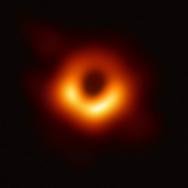University of Chicago scientists have made a new measurement of how fast the universe is expanding—using an entirely different kind of star than previous endeavors. That value falls in the center of a hotly debated question in astrophysics that may call for an entirely new model of the universe.
Scientists have known for almost a century that the universe is expanding, but the exact number for how fast it’s going has remained stubbornly elusive. In 2001, Prof. Wendy Freedman led a team that used distant stars to make a landmark measurement of this number, called the Hubble constant—but it disagrees with another major measurement, and the tension between the two numbers has persisted even as each side makes more and more accurate readings.
In a new paper to be published shortly in the Astrophysical Journal, Freedman and her team announced a new measurement of the Hubble constant using a kind of star known as a red giant. Their observations, made with NASA’s Hubble Space Telescope, indicate that the expansion rate for our corner of the universe is just under 70 kilometers per second per megaparsec—slightly smaller than their previous measurement, but not alleviating the tension.
“The Hubble constant is the cosmological parameter that sets the absolute scale, size and age of the universe; it is one of the most direct ways we have of quantifying how the universe evolves,” said Freedman, the John and Marion Sullivan University Professor in Astronomy and Astrophysics and a world-renowned astronomer. “The discrepancy that we saw before has not gone away, but this new evidence suggests that the jury is still out on whether there is an immediate and compelling reason to believe that there is something fundamentally flawed in our current model of the universe.”
A number behind the theory of the universe
The Hubble constant, named after pioneering astronomer and UChicago alum Edwin Hubble, underpins everything in the universe—from our estimate of when the Big Bang happened to how much dark matter exists. It helps scientists sketch out a theory of the history and structure of the universe; and conversely, if there are fault lines in that theory, an accurate measurement of the Hubble constant might lead them to it.
Twenty years ago, the Hubble Space Telescope Key Project team, which Freedman led, announced it had measured the value using distant stars called Cepheids, which pulse at regular intervals. Their program concluded that the value of the Hubble constant for our universe was 72. As astronomers have refined their analyses and gathered new data, this number has remained fairly stable, at about 73.
But more recently, scientists took a very different approach: building a model based on the rippling structure of light left over from the earliest moments of the Big Bang, which is called the Cosmic Microwave Background. If they ran a model forward in time, extrapolating from the first few moments of the universe, they reached a value of 67. That disagreement is significant—nearly 10 percent—and it has continued to solidify over time.
Both camps have looked for anything that might be causing the mismatch. “Naturally, questions arise as to whether the discrepancy is coming from some aspect that astronomers don’t yet understand about the stars we’re measuring, or whether our cosmological model of the universe is still incomplete,” Freedman said. “Or maybe both need to be improved upon.”
Mapping the stars
A central part of the challenge in measuring the universe is that it is very difficult to accurately calculate distances to distant objects. Freedman’s team originally looked at two types of stars that have reliable characteristics which allow astronomers to use them in combination as cosmological measuring sticks: Type Ia supernovae, which explode at a uniform brightness; and Cepheid variables, stars which pulse at regular intervals that can be matched to their peak brightnesses. But it’s still possible that there is something about Cepheids that scientists don’t yet fully understand, which could be introducing errors.
Freedman’s team sought to check their results by establishing a new and entirely independent path to the Hubble constant using an entirely different kind of star.
Certain stars end their lives as a very luminous kind of star called a red giant. At a certain point, the star undergoes a catastrophic event called a helium flash, in which the temperature rises to about 100 million degrees and the structure of the star is rearranged, which ultimately dramatically decreases its luminosity. (This will one day happen to our own sun, which will also become a red giant). Astronomers can see the point where all the luminosities of the stars drop off, and they can use this as a way to tell distance.
“The principle is simple,” Freedman said. “Imagine that you are standing near a street light that you know is 10 feet away. At regular intervals down the street you can seen more street lights, which get progressively dimmer the further away that they are. Knowing how far away and how bright the lamp is beside you, and then measuring how much fainter the more distant lamps appear to be, allows you to estimate the distances to each of the other lamps all down the road.”
Freedman’s team put this into action using sensitive cameras on the Hubble Space Telescope, searching for their new cosmic lampposts. By comparing the apparent luminosities of the distant red giants with nearby ones that we’ve measured with other methods, and pairing these readings with those from Type Ia supernovae, Freedman and her team were able to determine how far away each of the host galaxies were.
The next step is straightforward: How fast that galaxy is moving away from us is the product of its distance times the Hubble constant. Luckily, a galaxy’s velocity is simple to measure—the light coming from galaxies shifts depending on how fast the galaxy is moving away from us.
Their calculations gave a Hubble constant of 69.8 —straddling the two previously determined numbers.
“Our initial thought was that if there’s a problem to be resolved between the Cepheids and the Cosmic Microwave Background, then the red giant method can be the tie-breaker,” said Freedman.
“The red giant method is independent of the Cepheids and is incredibly precise. The stars used are of lower mass, have different evolutionary histories and are located in different regions of distant galaxies,” said Taylor Hoyt, a University of Chicago graduate student and co-author on the paper.
But the results do not appear to strongly favor one answer over the other.
“We are working at the frontier of what is currently known about cosmology,” Freedman concluded. “These results suggest that we do not have the final answer yet. The burden of proof is high when claims of new physics hang in the balance, but that’s what makes it exciting,” she said. “Either way the conflict resolves, it is important. We either confirm our standard model of cosmology, or we learn something new about the universe.”
The other University of Chicago co-author was Dylan Hatt, PhD’18. Carnegie scientist Barry Madore also has a visiting appointment at UChicago. Other co-authors included scientists with the Observatories of the Carnegie Institution for Science, Princeton University, Seoul National University, Penn State, Florida Atlantic University and the Leibniz Institute for Astrophysics-Potsdam.
Citation: “An Independent Determination of the Hubble Constant Based on the Tip of the Red Giant Branch.” Freedman et al, The Astrophysical Journal.
Funding: NASA, National Science Foundation, National Research Foundation of Korea, Ahmanson Foundation.

